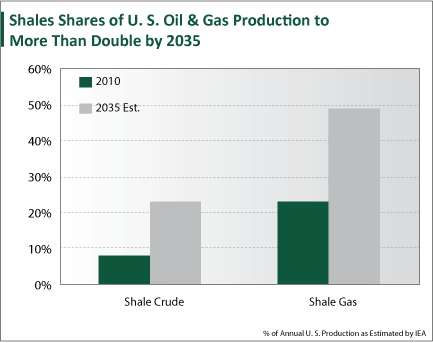It's no secret America has been in the midst of a natural gas revolution.
The technological advancement of fracking is causing nothing less than a full on shale boom, opening up amazing new profit opportunities if you know how to invest in natural gas - which I'll get to later.
According to the International Energy Agency (IEA), shale's share of U.S. oil & gas production will soar over the next 20 years. By 2035, the agency expects as much as 25% of U.S. oil and 50% of U.S. gas production will come from this source alone.

Thanks to the complexity and time involved, fracking a well is expensive, with costs running up to $10 million per well. It also requires a lot of room, a number of vehicles, and sophisticated and powerful equipment to get the job done.
But finding, drilling, and production costs are coming down as efficiencies are being gained. And this phenomenon will accelerate the rate at which supply hits the market.
Since late 2010, the time to drill a Bakken well has fallen dramatically - from 36 to 22 days currently.
Gas-directed rig counts are down 72%, after peaking at 1,054 rigs in late 2009. Despite that, dry gas production has grown by 15% between 2009 and 2012. Experts believe we'll see a further growth of 3% this year and as much as 5% next year.
Those plays that sport the heaviest oil mix are earning the most. But two of the most limiting factors in growing supply are pipeline and gas-processing capacities.
In some of the better known shales, such as the Marcellus, Utica, and Eagle Ford, as many as 1,800 wells are either dormant or under-producing. In most cases, either completion crews or a lack of infrastructure are preventing those producers from bringing the wells online.
What's more, production declines in many of the major basins should slow this year. Maturing wells tend to exhibit slowing patterns of decline.
The range of opportunities is wide.
How to Invest in Natural Gas
When it comes to transportation, billionaire energy investor T. Boone Pickens is big on natural gas. He thinks that, by the end of this decade, a majority of America's 18-wheel truck fleets will be powered by natural gas.
Some of the biggest fleets, like those of Wal-Mart and UPS, have already begun to make the switch. Others like Procter & Gamble and Nike say they plan to do the same.
Companies that produce equipment like engines that run on natural gas, or fueling stations that can accommodate the refueling of these fleets, are likely to perform well in the years ahead. And their markets are not exclusively in the U.S., but quite literally worldwide.
Another interesting angle with the American shale boom is the potential for liquefied natural gas (LNG). Natural gas costs a lot more in other parts of the world. Right now in the U.S., natural gas trades for about $4 per mcf (thousand cubic feet). But Japan pays more than $16 per mcf - a 400% premium - and Europeans pay about $10-11 per mcf.
Of course, there are costs involved in liquefying the gas and shipping it around the world... But the price difference right now is so drastic, the arbitrage opportunity to convert and transport cheap gas from where it's cheap and abundant, to where it's expensive and limited, has become overwhelming.
U.S. President Barack Obama has already mentioned that exporting U.S. natural gas would help lower the cost importing nations would pay.
So far, only Cheniere Energy Inc. (NYSE: LNG) has received a license to export gas from the U.S. But others are lined up, waiting to get their applications approved. Some analysts think action from Washington on this front could come soon.
But not everyone's crazy about the idea. Chemical producers, for example, that use oil and gas byproducts like propane, butane, and ethane as raw materials. They are benefitting from America's low natural gas prices. Some of these companies are investing big money in the U.S. to grow production, so they prefer to see their feedstock remain cheap.
Where do the opportunities exist?
There are many, and they touch all facets of the North American natural gas industry.
In my latest Real Asset Returns forecast issue, I highlight five types of companies that stand to profit the most from this natural gas revolution. These companies fulfill the needs that will become even more necessary as the revolution unfolds. They're also at the forefront of industries that have emerged from the push for LNG.
I'll continue to research this sector and look for potential investment candidates as the future of North American natural gas continues to grow.
If you want to follow the new opportunities I discover for how to invest in natural gas - as well as other resources like gold, silver and platinum - just go here to learn how to get connected. You'll get to hear our exclusive report on how to get in on a little-known profit opportunity I recently uncovered in Russia...
[epom]


